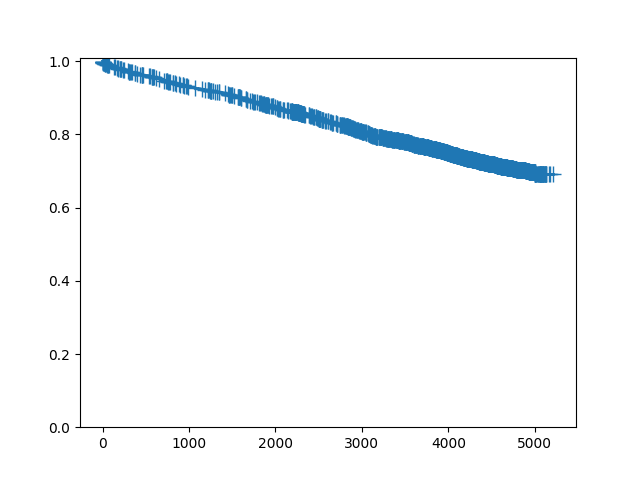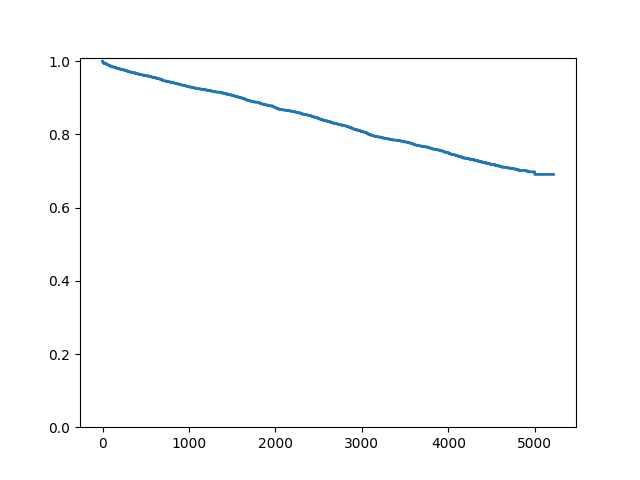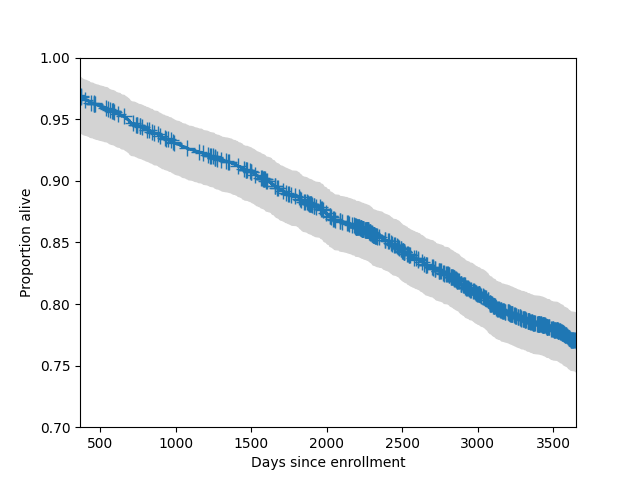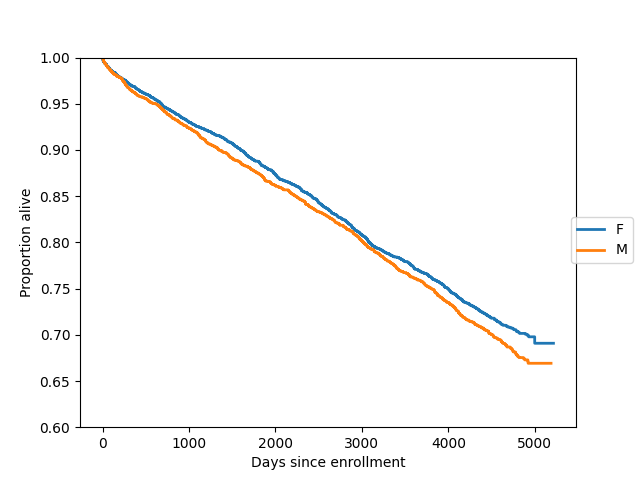生存与持续时间分析方法¶
statsmodels.duration 实现了一些用于处理删失数据的标准方法。这些方法最常用于数据包含从原点时间点到发生某个感兴趣事件的时间持续时间的情况。一个典型的例子是医学研究,其中原点是受试者被诊断出患有某种疾病的时间,感兴趣的事件是死亡(或疾病进展、恢复等)。
目前只处理右删失。右删失发生在当我们知道一个事件发生在给定时间 t 之后,但我们不知道确切的事件时间。
生存函数估计与推断¶
statsmodels.api.SurvfuncRight 类可以用于估计使用可能被右删失的数据的生存函数。 SurvfuncRight 实现了几种推断程序,包括生存分布分位数的置信区间、生存函数的逐点和同时置信带以及绘图程序。 duration.survdiff 函数提供用于比较生存分布的检验程序。
这里,我们使用来自 flchain 研究的数据创建一个 SurvfuncRight 对象,该数据可以通过 R 数据集存储库获得。我们只对女性受试者拟合生存分布。
In [1]: import statsmodels.api as sm
In [2]: data = sm.datasets.get_rdataset("flchain", "survival").data
In [3]: df = data.loc[data.sex == "F", :]
In [4]: sf = sm.SurvfuncRight(df["futime"], df["death"])
可以通过调用 summary 方法查看拟合生存分布的主要特征
In [5]: sf.summary().head()
Out[5]:
Surv prob Surv prob SE num at risk num events
Time
0 0.999310 0.000398 4350 3.0
1 0.998851 0.000514 4347 2.0
2 0.998621 0.000563 4343 1.0
3 0.997931 0.000689 4342 3.0
4 0.997471 0.000762 4338 2.0
我们可以获得生存分布分位数的点估计和置信区间。由于只有大约 30% 的受试者在这项研究中死亡,我们只能估计低于 0.3 概率点的分位数
In [6]: sf.quantile(0.25)
Out[6]: np.int64(3995)
In [7]: sf.quantile_ci(0.25)
Out[7]: (np.int64(3776), np.int64(4166))
要绘制单个生存函数,请调用 plot 方法
In [8]: sf.plot()
Out[8]: <Figure size 640x480 with 1 Axes>

由于这是一个大型数据集,并且存在大量删失,因此我们可能希望不绘制删失符号
In [9]: fig = sf.plot()
In [10]: ax = fig.get_axes()[0]
In [11]: pt = ax.get_lines()[1]
In [12]: pt.set_visible(False)

我们也可以在图中添加 95% 的同时置信带。通常,这些带只绘制在分布的中心部分。
In [13]: fig = sf.plot()
In [14]: lcb, ucb = sf.simultaneous_cb()
In [15]: ax = fig.get_axes()[0]
In [16]: ax.fill_between(sf.surv_times, lcb, ucb, color='lightgrey')
Out[16]: <matplotlib.collections.PolyCollection at 0x7f19af039cf0>
In [17]: ax.set_xlim(365, 365*10)
Out[17]: (365.0, 3650.0)
In [18]: ax.set_ylim(0.7, 1)
Out[18]: (0.7, 1.0)
In [19]: ax.set_ylabel("Proportion alive")
Out[19]: Text(0, 0.5, 'Proportion alive')
In [20]: ax.set_xlabel("Days since enrollment")
Out[20]: Text(0.5, 0, 'Days since enrollment')

这里,我们在同一个轴上绘制两个组(女性和男性)的生存函数
In [21]: import matplotlib.pyplot as plt
In [22]: gb = data.groupby("sex")
In [23]: ax = plt.axes()
In [24]: sexes = []
In [25]: for g in gb:
....: sexes.append(g[0])
....: sf = sm.SurvfuncRight(g[1]["futime"], g[1]["death"])
....: sf.plot(ax)
....:
In [26]: li = ax.get_lines()
In [27]: li[1].set_visible(False)
In [28]: li[3].set_visible(False)
In [29]: plt.figlegend((li[0], li[2]), sexes, loc="center right")
Out[29]: <matplotlib.legend.Legend at 0x7f19aef908b0>
In [30]: plt.ylim(0.6, 1)
Out[30]: (0.6, 1.0)
In [31]: ax.set_ylabel("Proportion alive")
Out[31]: Text(0, 0.5, 'Proportion alive')
In [32]: ax.set_xlabel("Days since enrollment")
Out[32]: Text(0.5, 0, 'Days since enrollment')

我们可以使用 survdiff 正式比较两个生存分布,它实现了一些标准的非参数程序。默认程序是 logrank 检验
In [33]: stat, pv = sm.duration.survdiff(data.futime, data.death, data.sex)
以下是 survdiff 实现的其他一些检验程序
# Fleming-Harrington with p=1, i.e. weight by pooled survival time
In [34]: stat, pv = sm.duration.survdiff(data.futime, data.death, data.sex, weight_type='fh', fh_p=1)
# Gehan-Breslow, weight by number at risk
In [35]: stat, pv = sm.duration.survdiff(data.futime, data.death, data.sex, weight_type='gb')
# Tarone-Ware, weight by the square root of the number at risk
In [36]: stat, pv = sm.duration.survdiff(data.futime, data.death, data.sex, weight_type='tw')
回归方法¶
比例风险回归模型(“Cox 模型”)是一种用于删失数据的回归技术。它们允许事件时间的变化根据协变量来解释,类似于在线性或广义线性回归模型中所做的那样。这些模型以“风险比”的形式表达协变量的影响,这意味着风险(瞬时事件率)会根据协变量的值乘以给定的因子。
In [37]: import statsmodels.api as sm
In [38]: import statsmodels.formula.api as smf
In [39]: data = sm.datasets.get_rdataset("flchain", "survival").data
In [40]: del data["chapter"]
In [41]: data = data.dropna()
In [42]: data["lam"] = data["lambda"]
In [43]: data["female"] = (data["sex"] == "F").astype(int)
In [44]: data["year"] = data["sample.yr"] - min(data["sample.yr"])
In [45]: status = data["death"].values
In [46]: mod = smf.phreg("futime ~ 0 + age + female + creatinine + np.sqrt(kappa) + np.sqrt(lam) + year + mgus", data, status=status, ties="efron")
In [47]: rslt = mod.fit()
In [48]: print(rslt.summary())
Results: PHReg
====================================================================
Model: PH Reg Sample size: 6524
Dependent variable: futime Num. events: 1962
Ties: Efron
--------------------------------------------------------------------
log HR log HR SE HR t P>|t| [0.025 0.975]
--------------------------------------------------------------------
age 0.1012 0.0025 1.1065 40.9289 0.0000 1.1012 1.1119
female -0.2817 0.0474 0.7545 -5.9368 0.0000 0.6875 0.8280
creatinine 0.0134 0.0411 1.0135 0.3271 0.7436 0.9351 1.0985
np.sqrt(kappa) 0.4047 0.1147 1.4988 3.5288 0.0004 1.1971 1.8766
np.sqrt(lam) 0.7046 0.1117 2.0230 6.3056 0.0000 1.6251 2.5183
year 0.0477 0.0192 1.0489 2.4902 0.0128 1.0102 1.0890
mgus 0.3160 0.2532 1.3717 1.2479 0.2121 0.8350 2.2532
====================================================================
Confidence intervals are for the hazard ratios
有关更详细的示例,请参见 示例。
维基上有关于 PHReg 和生存分析的一些笔记本示例:维基笔记本,用于 PHReg 和生存分析
参考文献¶
Cox 比例风险回归模型的参考文献
T Therneau (1996). Extending the Cox model. Technical report.
http://www.mayo.edu/research/documents/biostat-58pdf/DOC-10027288
G Rodriguez (2005). Non-parametric estimation in survival models.
http://data.princeton.edu/pop509/NonParametricSurvival.pdf
B Gillespie (2006). Checking the assumptions in the Cox proportional
hazards model.
http://www.mwsug.org/proceedings/2006/stats/MWSUG-2006-SD08.pdf
模块参考¶
用于处理生存分布的类是
|
生存函数的估计与推断。 |
比例风险回归模型类是
|
Cox 比例风险回归模型 |
比例风险回归结果类是
|
用于包含拟合 Cox 比例风险生存模型的结果的类。 |
主要辅助类是
|
表示离散分布集合的类。 |